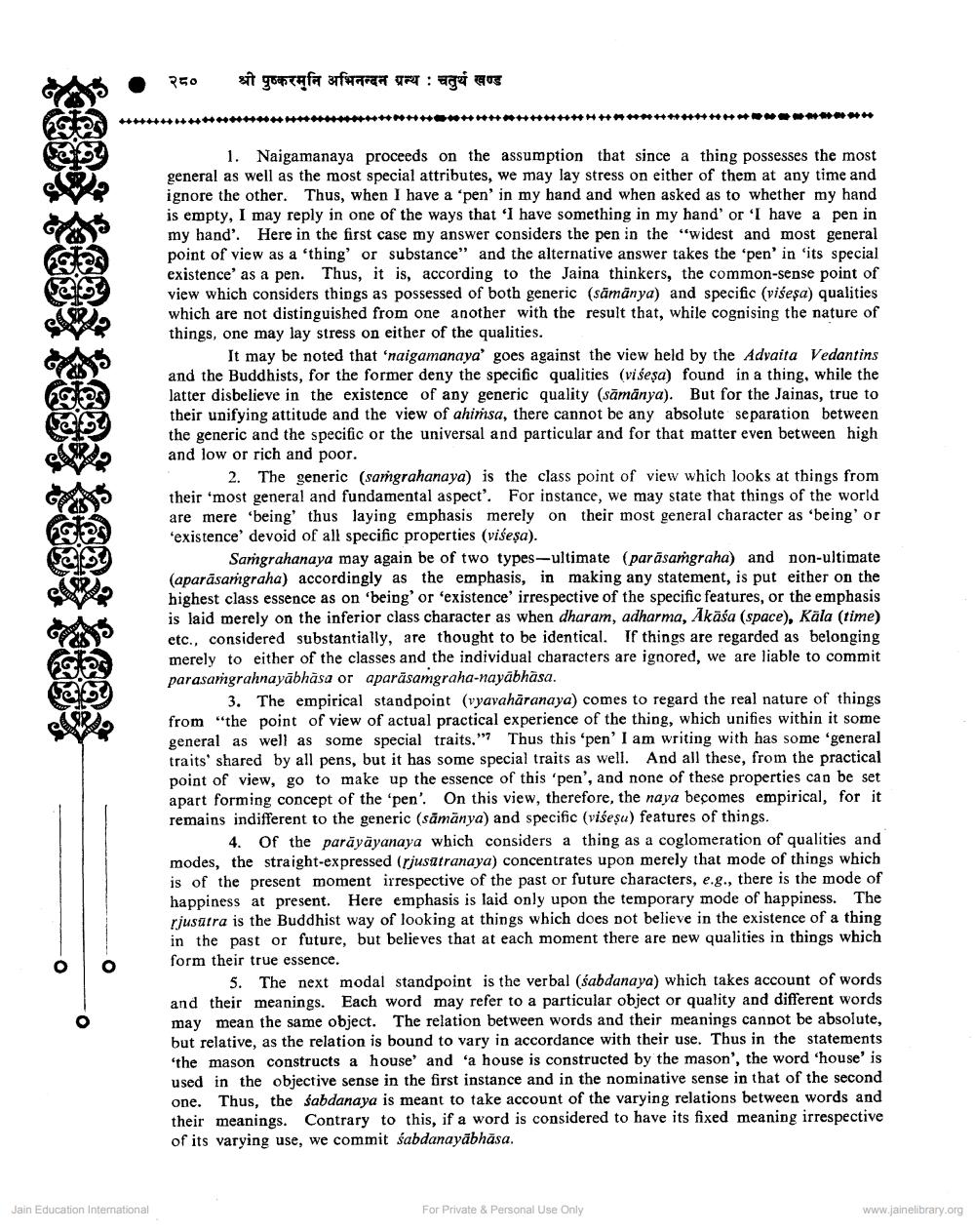________________
। २८०
श्री पुष्करमुनि अभिनन्दन ग्रन्थ : चतुर्थ खण्ड
1. Naigamanaya proceeds on the assumption that since a thing possesses the most general as well as the most special attributes, we may lay stress on either of them at any time and ignore the other. Thus, when I have a 'pen' in my hand and when asked as to whether my hand is empty, I may reply in one of the ways that 'I have something in my hand' or 'I have a pen in my hand'. Here in the first case my answer considers the pen in the "widest and most general point of view as a 'thing' or substance" and the alternative answer takes the 'pen' in 'its special existence as a pen. Thus, it is, according to the Jaina thinkers, the common sense point of view which considers things as possessed of both generic (sāmānya) and specific (višeşa) qualities which are not distinguished from one another with the result that, while cognising the nature of things, one may lay stress on either of the qualities.
It may be noted that 'naigamanaya' goes against the view held by the Advaita Vedantins and the Buddhists, for the former deny the specific qualities (višeşa) found in a thing, while the latter disbelieve in the existence of any generic quality (samanya). But for the Jainas, true to their unifying attitude and the view of ahimsa, there cannot be any absolute separation between the generic and the specific or the universal and particular and for that matter even between high and low or rich and poor.
2. The generic (saṁgrahanaya) is the class point of view which looks at things from their most general and fundamental aspect'. For instance, we may state that things of the world are mere being thus laying emphasis merely on their most general character as being or 'existence devoid of all specific properties (višeşa).
Sangrahanaya may again be of two types-ultimate (par āsargraha) and non-ultimate (aparāsargraha) accordingly as the emphasis, in making any statement, is put either on the highest class essence as on 'being' or 'existence' irrespective of the specific features, or the emphasis is laid merely on the inferior class character as when dharam, adharma, Akāśa (space), Kala (time) etc., considered substantially, are thought to be identical. If things are regarded as belonging merely to either of the classes and the individual characters are ignored, we are liable to commit parasangrahnayābhāsa or aparāsamgraha-nayabhasa.
3. The empirical standpoint (vyavahāranaya) comes to regard the real nature of things from the point of view of actual practical experience of the thing, which unifies within it some general as well as some special traits." Thus this 'pen' I am writing with has some 'general traits shared by all pens, but it has some special traits as well. And all these, from the practical point of view, go to make up the essence of this 'pen', and none of these properties can be set apart forming concept of the 'pen'. On this view, therefore, the naya becomes empirical, for it remains indifferent to the generic (sāmānya) and specific (višeșu) features of things.
4. Of the paräväyanaya which considers a thing as a coglomeration of qualities and modes, the straight-expressed (rjusutranaya) concentrates upon merely that mode of things which is of the present moment irrespective of the past or future characters, e.g., there is the mode of happiness at present. Here emphasis is laid only upon the temporary mode of happiness. The rjusutra is the Buddhist way of looking at things which does not believe in the existence of a thing in the past or future, but believes that at each moment there are new qualities in things which form their true essence.
5. The next modal standpoint is the verbal (sabdanaya) which takes account of words and their meanings. Each word may refer to a particular object or quality and different words may mean the same object. The relation between words and their meanings cannot be absolute, but relative, as the relation is bound to vary in accordance with their use. Thus in the statements 'the mason constructs a house and a house is constructed by the mason', the word 'house' is used in the objective sense in the first instance and in the nominative sense in that of the second one. Thus, the sabdanaya is meant to take account of the varying relations between words and their meanings. Contrary to this, if a word is considered to have its fixed meaning irrespective of its varying use, we commit sabdanayābhāsa.
Jain Education International
For Private & Personal Use Only
www.jainelibrary.org




